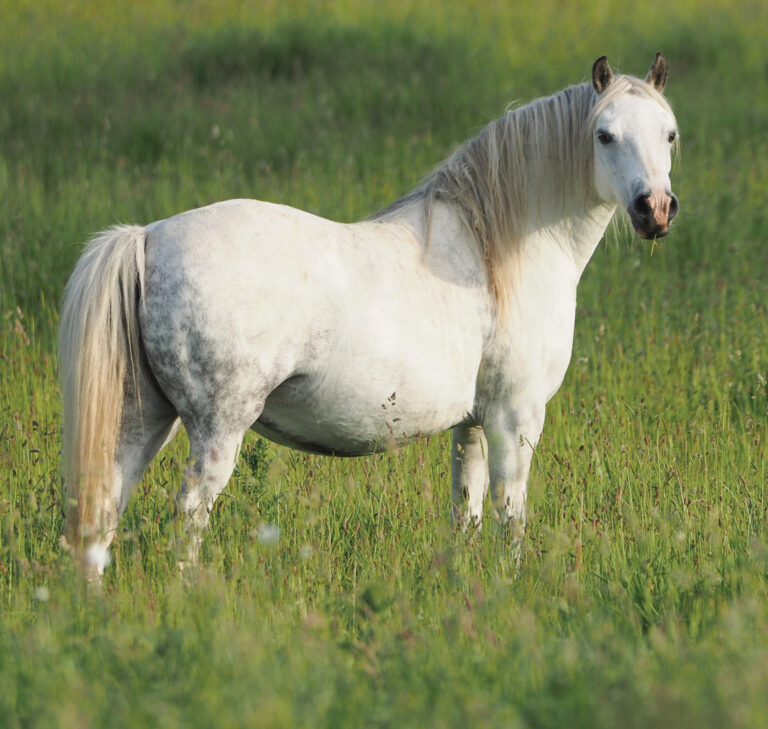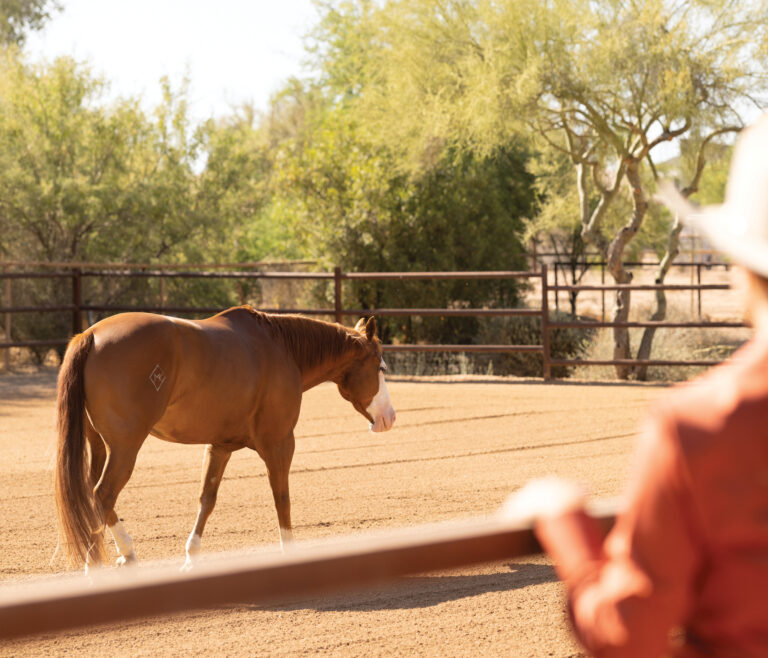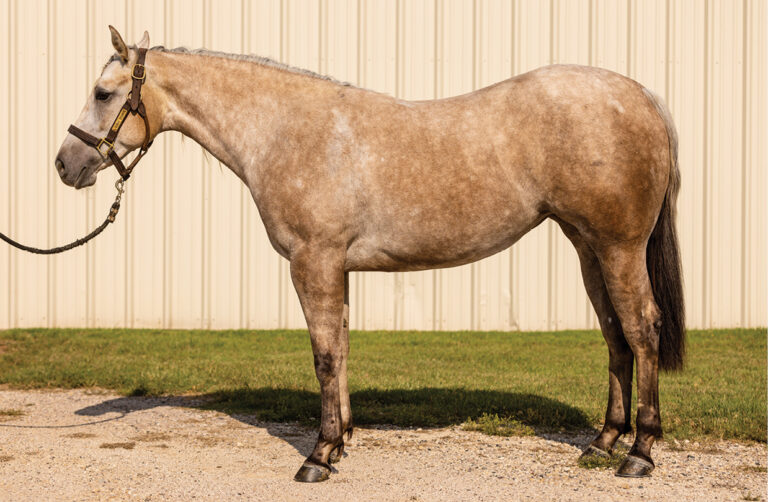You arrive at the barn to find your horse with a snotty nose. Do you clean him up and ride him anyway? Call your veterinarian for an emergency visit? Or do you decide to take the day off and see what your horse looks like the next morning?
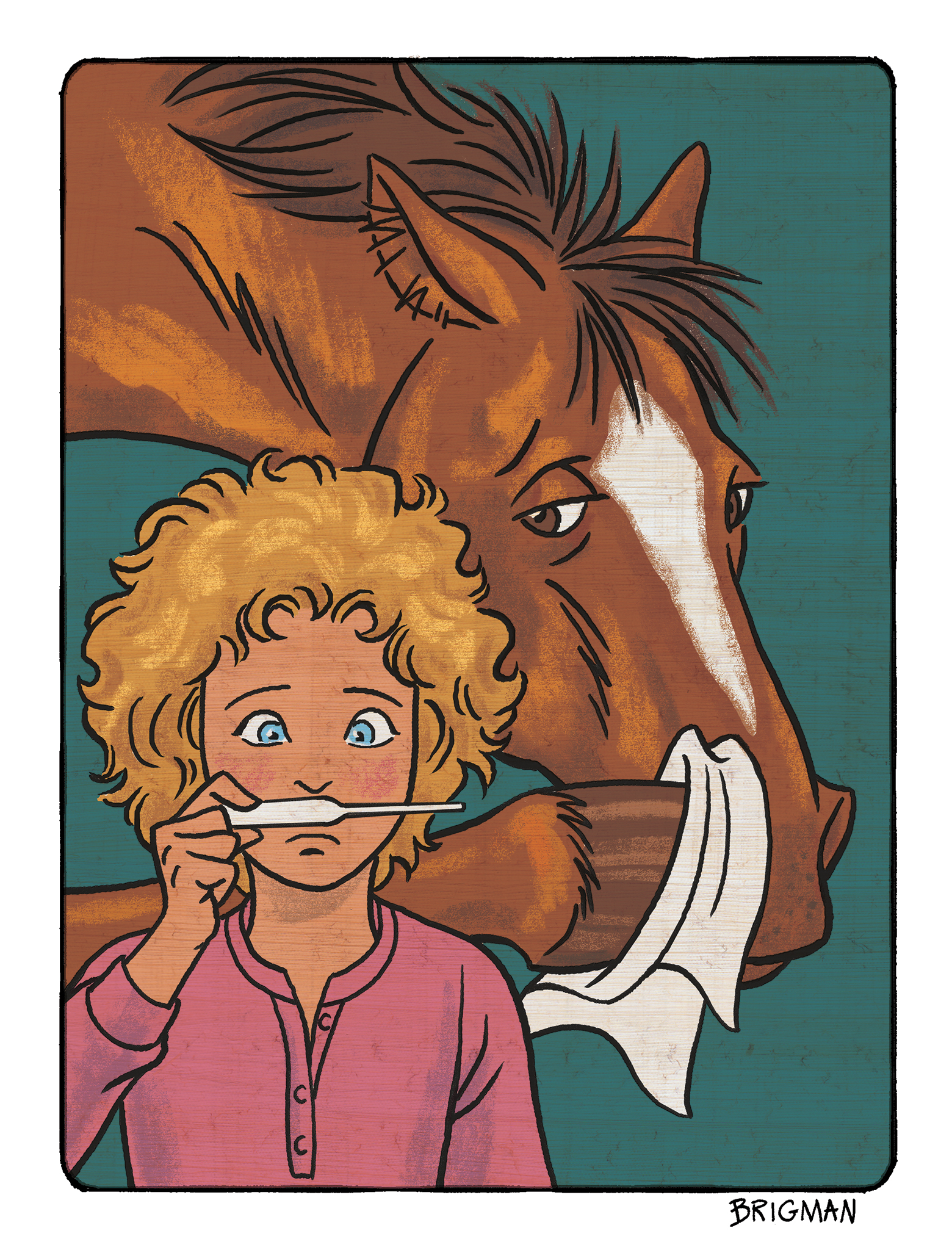
The answer isn’t simple. The cause of your horse’s nasal discharge can range from something as simple as a little dust irritation to as serious as a life-threatening pneumonia.
Here, I’ll give you the tools you need to determine what to do when you find your horse with a nasal discharge. First, I’ll tell exactly what mucous is. Next, I’ll explain how to evaluate your horse’s discharge by giving you five questions to answer about its nature. I’ll describe what each answer likely means about your horse’s condition and recommend an action step.
Finally, I’ll outline five common snotty-nose scenarios. For each scenario, I’ll give you the most likely cause of the discharge, whether it’s an emergency, and a recommended action plan. Along the way, I’ll tell you about a different reason for nasal discharge that looks alarming but is usually easily resolved.
MORE FROM BARB CRABBE, DVM: What are Horse Heaves and How Do You Treat Them?
Mucous, Defined
Mucous in your horse’s nose is composed of water, salt, and a group of proteins called mucins that give it its sticky, stretchy character. This mucous acts as a blanket that protects the sensitive tissues of your horse’s nasal passages and prevents them from drying out.
Because mucous is sticky and thick, it also acts a bit like flypaper, trapping bacteria, viruses, and other foreign substances to prevent them from moving farther down into your horse’s respiratory tract. Finally, mucous contains antibodies that recognize and attack foreign invaders.
When your horse has a cold or allergy that affects his respiratory tract, his tissues produce excessive mucous. So it can better perform its important job of flushing out unwanted invaders. If something causes inflammation, a type of white blood cells called neutrophils rush to the area. And if there’s an actual infection, neutrophils gobble up bacteria or viruses, then release enzymes to destroy them.
Five Questions
When your horse has a snotty nose, answering the following five questions will help you determine your best course of action.
1. One nostril or two?
One nostril: If the nasal discharge is coming from only from one nostril, you can usually localize your horse’s problem to somewhere in front of his pharynx where the nasal passages meet. Problems that typically cause a one-sided discharge include sinusitis (sometimes related to a tooth-root issue), a nasal-passage abnormality (such as a foreign body, cyst, or abscess), or a problem in a guttural pouch. (Guttural pouches are a pair of blind sacs at the back of the nasal passages.)
Action step: Call your vet. If a one-sided nasal discharge is persistent, your vet will recommend radiographs of your horse’s skull and/or an endoscopic exam to help diagnose an underlying cause.
Two nostrils: A nasal discharge in both nostrils is more likely to be caused by a problem in the pharynx, trachea, or lungs. Equine asthma, an upper respiratory virus, and pneumonia would all be on the list of possible explanations—but so would a simple dust sensitivity.
Action step: You’ll need to do a further evaluation before you can decide what to do.
2. Hot or not?
Hot: If your horse has a fever (a temperature higher than 101.5 degrees Fahrenheit), there’s a good chance he’s experiencing a viral or bacterial infection. As a rule of thumb, viral infections tend to cause higher fevers than bacterial infections. If your horse’s temperature is over 104 degrees Fahrenheit, your vet will suspect a virus.

Action step: If your horse has a fever, call your vet. Your vet may recommend sampling your horse’s nasal passages to try to identify a specific viral or bacterial cause, which will help you establish biosecurity measures if other horses are at risk. Your vet will then recommend appropriate treatment based on the results of laboratory tests.
Not hot: If your horse’s temperature is normal, his nasal discharge may be due to allergies or equine asthma. However, just because your horse doesn’t have a fever, you can’t rule out an infectious cause. In fact, when your horse contracts a virus, he’ll often develop a fever that resolves long before the nasal discharge ever starts.
Action step: None needed unless the nature of the discharge changes or other signs appear.
3. Thin or thick?
Thin: Mucous typically starts out watery. When your horse’s nasal discharge is thin, that’s a good indicator the problem is a new one—and may be transient. As a rule of thumb, a thin, watery discharge is less concerning than a thick and gooey one.
Action step: None needed unless the nature of the discharge changes or other signs appear.
Thick: Mucous becomes thicker over time due to the foreign material and debris that has accumulated. If your horse’s nasal discharge is thick and sticky, that’s a good indicator that whatever has been causing the discharge has been a problem for a period of time.
Action step: A thick nasal discharge that’s persistent for a week or more is probably worthy of a visit from your vet—even if your horse isn’t showing any other signs.
4. Clear or creamy?
Clear: A nasal discharge that’s primarily composed of mucous will be clear and is less concerning than one that’s creamy or discolored.
Action step: None needed unless the discharge changes in nature.
Creamy: A persistent discharge may turn creamy as foreign material and debris accumulate. If the neutrophils that rush to the area during inflammation or infection sit around for a period of time, they can begin to oxidize and become discolored—just like a slice of apple that’s left out in the air. That’s the most likely cause for yellowish or brownish mucous. Neutrophils also release enzymes that contain iron, specifically one called myeloperoxidase. That’s what makes your horse’s snot turn green. Contrary to popular belief, thick, green, or yellow mucous doesn’t necessarily mean your horse has a bacterial infection.
One final touch of color could be blood—either bright red (fresh) or reddish brown (old). Just like humans, horses can get bloody noses simply due to a disruption of a small blood vessel in a nasal passage. A bloody nose can also be due to bleeding from the lungs (most common during exercise) or from large blood vessels within the guttural pouch (most common with an infection).
Action step: By itself, a thick, discolored nasal discharge doesn’t mean your horse needs antibiotics. However, it does indicate significant inflammation, and probably warrants a call to your vet for advice. Lab work, including an analysis of samples taken from your horse’s nasal passages or airways, can help your vet determine the underlying cause of your horse’s discharge. If a bloody nose is excessive, persistent, or happens more than once, it’s probably time to call your vet.
5. Sweet or sour?
Sweet: On a good day, your horse’s breath smells sweet and warm. Even with a nasal discharge, that smell may stay the same—and you can feel relieved.
Action step: None needed unless the nature of the discharge changes or other signs appear.
Sour: If your horse’s nasal discharge smells sour or rotten, that might be cause for concern. Most commonly, a one-sided nasal discharge with a potent smell can be an indicator of a bone infection that’s often due to a rotten tooth or infected sinus.
Action step: Call your vet. If your horse’s nasal discharge has a rotten smell, your vet will most likely recommend an exam. He or she will likely check your horse’s teeth and will probably recommend radiographs and/or endoscopy.
MORE FROM BARB CRABBE, DVM: Myths and Facts About Horse Hives
________________________________
A Different Kind of Discharge
“I think my horse is dying! He must have pneumonia, because he’s coughing like crazy and has thick disgusting discharge coming from both nostrils. I just don’t understand it—he seemed fine yesterday. I need you now.”
The minute I hear this sort of message on my pager, I’m already pretty sure I know the answer. The good news is that the horse really isn’t dying, and he probably doesn’t have pneumonia. In fact, this is a classic description of an esophageal blockage—the equine version of choke.
An equine choke is very different from a human choke. It involves a horse’s esophagus (between his mouth and stomach) not his trachea (the passage to his lungs). Although the horse’s behavior may appear dramatic, he isn’t in any imminent danger of collapse or death. In fact, the majority of equine chokes resolve spontaneously, before we can even make it to your barn.
If your horse has a copious nasal discharge that’s bubbly and slimy, and contains food particles, chances are, he’s choking. He’ll also stretch his neck out uncomfortably and cough repeatedly. Wait 10 or 15 minutes before you call your vet, and gently massage the esophagus, which runs along the groove on the left side of his neck. You may be able to relieve your horse’s choke yourself.
If a choking episode persists for 30 minutes or longer, call your vet. He or she will sedate your horse, pass a tube into your horse’s esophagus, and flush the blockage with water.
________________________________
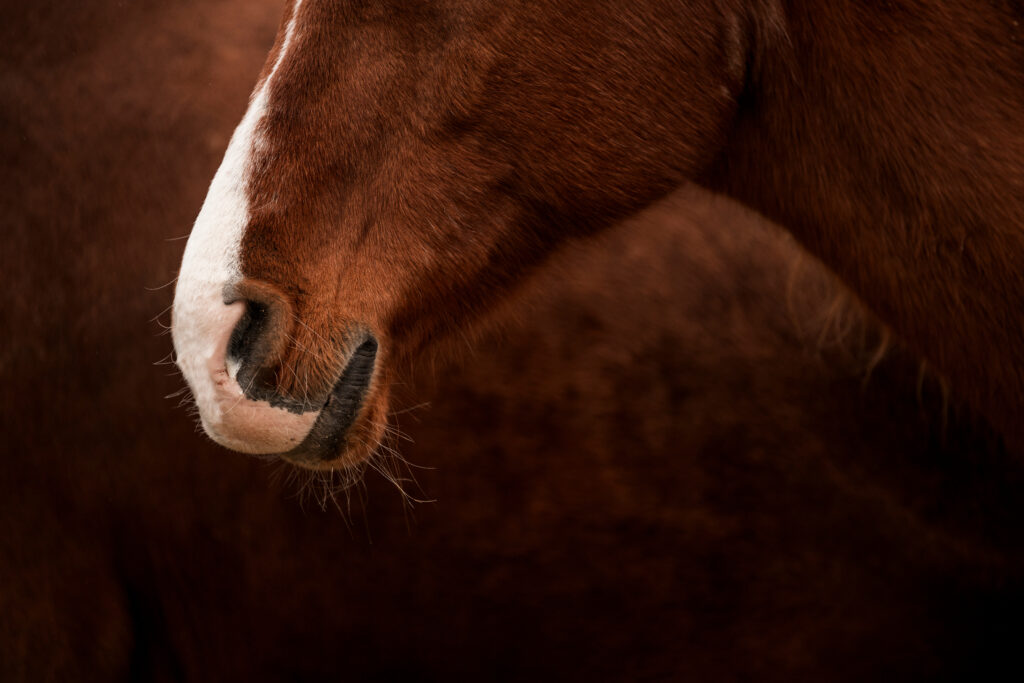
Common Scenarios
Here’s a rundown of five common scenarios to further help you determine what to do when your horse has a snotty nose.
Scenario #1: Your horse has a one-sided nasal discharge that’s thick, yellow, and stinky. He doesn’t have a fever.
Most likely cause: Sinusitis related to a rotten tooth.
Emergency? No.
Action step: Call your vet for a regular appointment. The nasal discharge isn’t likely to resolve on its own, and additional diagnostics will be recommended.
Scenario #2: Your horse has a two-sided nasal discharge that’s thin and clear, and he has a fever of 105 degrees Fahrenheit.
Most likely cause: A respiratory virus.
Emergency? Maybe.
Action step: Call your vet, even if it’s after hours. He or she may not pay you a visit right away, but will help you manage your horse’s fever and offer biosecurity advice to protect other horses that might be exposed. If your vet doesn’t see your horse immediately, he or she may schedule a visit during regular hours to examine your horse and run appropriate laboratory tests.
Scenario #3: Your horse has a thick, two-sided nasal discharge. You’ve been watching it for a week, and it hasn’t gotten any better. He doesn’t have a fever and seems reasonably happy.
Most likely cause: An allergy or a mild respiratory virus.
Emergency? No.
Action step: Call your vet for advice. He or she may make suggestions for managing your horse’s environment to minimize respiratory irritants and can help you decide how long to “ride it out” in case it is a virus. He or she may also suggest examining your horse and running additional diagnostic tests to try to differentiate between a virus and an allergy.
Scenario #4: Your horse has a one-sided, blood-tinged nasal discharge. He doesn’t have a fever.
Most likely cause: A disrupted blood vessel in your horse’s nostril.
Emergency? No.
Action step: Keep an eye on your horse. If the bloody discharge is persistent or happens repeatedly, call your vet to schedule an exam during regular hours. He or she will likely recommend an endoscopic exam to try to identify where the blood is coming from.
Scenario #5: Your horse has a two-sided nasal discharge that’s thick and yellow. It’s been there for about a week, and today he has a temperature of 103 degrees F.
Most likely cause: A viral or bacterial infection.
Emergency? Maybe.
Action step: Call your vet for advice. He or she can decide whether your horse needs to be seen immediately or if it can wait for regular hours. Some viral respiratory infections can have biphasic fever spikes—meaning afflicted horses will have a fever when first infected that can spike again after a period of several days. It’s also possible to have a secondary bacterial infection on top of a virus or allergy. This combination of symptoms is likely to require a visit from your vet and additional diagnostics.
MORE FROM BARB CRABBE, DVM: What is Your Vet Thinking During an Emergency?

